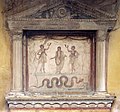Aedicula

An aedicule (plural Ädikulä ; from Latin aedicula , plural aediculae ) is a small ancient building or component .
History and description
Originally aedicula is a diminutive of aedes , which denotes a house or a temple in particular, accordingly aedicula is a small house or "little temple". Aedicula are especially the small replicas of temples that were used to decorate a sacellum , an enclosed sanctuary, as is typical of the oldest Roman cults. These aediculae were then mostly small structures with a niche in which the cult image of the deity was located.
In this reduced form, aedicules appear as an architectural element: a small wall structure that looked like a temple front and in which a statue was located. Later, each column structure , which consisted of columns , pillars or pilasters and a triangular or segmented arch gable and framed a niche , was called aedicula. This style element can be found in the Hellenistic and Roman architectural styles as well as in the architectural styles linked to antiquity, Renaissance , Baroque and Classicism . The aedicula was mostly used to structure large wall surfaces. It can often be found on large gates , city gates or triumphal arches and on large buildings such as thermal baths and palaces . In the Middle Ages , a small private chapel (usually a burial chapel) was also called this.
The following possible meanings of aedicula are to be distinguished:
- Shrine in the sense of a lararium
- Tomb or part of a tomb with the urn or a portrait of the deceased.
- small ancient temple
- small structure to preserve a still image
- Framing of niches or of windows with columns or with a small roof and gable (house motif - triangular gable).
The latter two meanings are often used in connection with an apse or facade .
There are forms of the aedicula that are not directly based on ancient models. These occur in modern architecture, including in public areas.
In Roman wall painting , especially Antonine wall painting , the aedicule is a frequent motif for creating an illusionistic architecture. This motif with the same purpose already exists in the second style of Pompeiian wall painting .
In the Greek cultural area the aedicula corresponds to the naiskos .
Naiskos : Greek grave stele, around 430–400 BC
Lararium in the Casa dei in Vettii in Pompeii, around 50
Tomb for Julius Wilhelm Brühl in the Heidelberg Bergfriedhof, 19th century.
Grave temples for von Finckh and von Berger on the Gertrudenfriedhof in Oldenburg (Oldb)
Tomb for General Friedrich Wilhelm von Rauch ( Invalidenfriedhof Berlin - Design: Friedrich Wilhelm IV. / Friedrich August Stüler )
literature
- Paul Habel : Aedicula . In: Paulys Realencyclopadie der classischen Antiquity Science (RE). Volume 1, Stuttgart 1893ff., Col. 445 f.
- Henner von Hesberg : Elements of early imperial aedicula architecture. In: Annual books of the Austrian Archaeological Institute. Vol. 53, 1981/1982, ISSN 0078-3579 , pp. 43-86, pp. 43, 86.
- Peter Noelke : Ara et Aedicula - Two types of votive monuments in the Germanic provinces. In: Bonner Jahrbücher . Vol. 190, 1990, pp. 79-124.
- Wolfgang Herrmann: Aedicula . In: Otto Schmitt (Ed.): Reallexikon zur Deutschen Kunstgeschichte . Volume 1: A - Construction. Metzler, Stuttgart 1937, Col. 167-172.
Web links
- Aedicula in The large art dictionary by PW Hartmann .
- Ädikula in: Reallexikon zur Deutschen Kunstgeschichte






